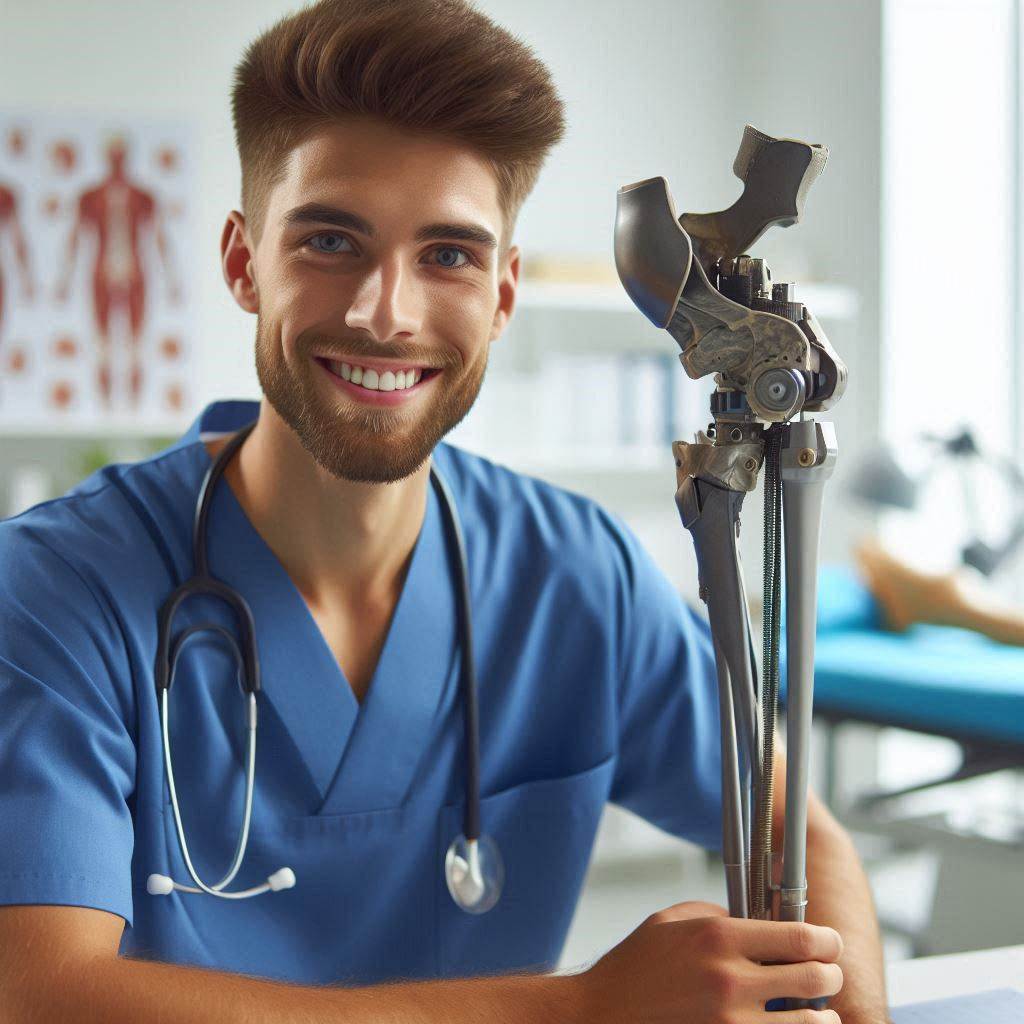Introduction
Orthotist Prosthetist Allied Health Professions: In the vast landscape of healthcare, orthotists and prosthetists play crucial roles alongside other allied health professions, each contributing uniquely to patient care and rehabilitation.
This blog post explores the distinctions between orthotists, prosthetists, and other allied health professionals, highlighting their significance in enhancing quality of life through specialized interventions.
Orthotists and prosthetists are instrumental in designing, fitting, and customizing orthotic and prosthetic devices that assist patients with mobility impairments.
These professionals collaborate closely with physicians, physical therapists, and occupational therapists to ensure optimal patient outcomes.
Their expertise lies not only in technical proficiency but also in understanding the biomechanics of human movement and the psychological impact of prosthetic limbs and orthotic devices on patients’ lives.
Other allied health professions such as physical therapists, occupational therapists, and speech-language pathologists work in tandem with orthotists and prosthetists to provide comprehensive care.
Physical therapists focus on restoring mobility and functionality through exercise and rehabilitation programs, while occupational therapists help patients regain independence in daily activities.
Speech-language pathologists address communication disorders, enhancing overall patient well-being.
This blog post aims to elucidate the roles of orthotists, prosthetists, and other allied health professionals, offering insights into their specialized contributions to healthcare.
By understanding the distinctions and synergies among these professions, readers will gain a deeper appreciation for the multidisciplinary approach to patient care in rehabilitation settings.
Whether you’re considering a career in healthcare or seeking to understand the intricate network of professionals involved in patient recovery, this post provides a comprehensive overview of how orthotists, prosthetists, and allied health professionals collaborate to improve lives.
Education and Training
Orthotist/Prosthetist
To become an orthotist/prosthetist, one must complete a bachelor’s degree in orthotics and prosthetics or a related field.
Following undergraduate studies, aspiring orthotist/prosthetists must complete a master’s degree program accredited by the National Commission on Orthotic and Prosthetic Education (NCOPE).
Clinical experience is a vital component, with students required to complete a minimum of 2,000 hours of supervised clinical practice.
This extensive training ensures that orthotist/prosthetists have the necessary skills to assess, design, and fit orthoses and prostheses effectively.
Physical Therapy
Physical therapists require a Doctor of Physical Therapy (DPT) degree from an accredited program.
The Doctor of Physical Therapy program typically takes 3 years to complete.
Like orthotist/prosthetists, physical therapists also need to complete supervised clinical internships.
Coursework for physical therapy includes anatomy, physiology, biomechanics, and therapeutic exercise.
Occupational Therapy
Occupational therapists must obtain a Master’s degree in Occupational Therapy (MOT).
Transform Your Career Today
Unlock a personalized career strategy that drives real results. Get tailored advice and a roadmap designed just for you.
Start NowThe Master’s program typically takes 2-3 years to complete.
Clinical fieldwork is a crucial part of the training, allowing students to gain hands-on experience.
Coursework for occupational therapy includes human development, psychology, and activity analysis.
Read: How to Become an Orthotist/Prosthetist: A Step-by-Step Guide
Scope of Practice
Orthotists and Prosthetists are specialized healthcare professionals who are responsible for providing orthotic and prosthetic care to patients. Their scope of practice includes:
Responsibilities and Duties
- Evaluating patients’ needs for orthotic or prosthetic devices.
- Designing and customizing orthotic and prosthetic devices for individual patients.
- Fitting and adjusting devices to ensure proper function and comfort.
- Educating patients on how to use and care for their devices.
- Collaborating with other healthcare professionals to ensure comprehensive care for patients.
Comparison to Other Allied Health Professions
Orthotist Prosthetist Allied Health Professions: When compared to other allied health professions, orthotists and prosthetists have a unique focus on providing support and mobility to patients with physical impairments.
While occupational therapists and physical therapists may also work with patients needing assistive devices, orthotists and prosthetists have specific expertise in designing and fitting orthotic and prosthetic devices.
Specific Skills and Expertise Required
- Knowledge of human anatomy and biomechanics.
- Technical skills in measuring and fabricating orthotic and prosthetic devices.
- Communication skills to collaborate with patients and healthcare team members.
- Problem-solving abilities to address challenges in device design and fitting.
- Continuous learning to stay updated on advancements in orthotics and prosthetics.
Overall, orthotists and prosthetists play a crucial role in enhancing the quality of life for individuals with physical disabilities by providing customized assistive devices tailored to their unique needs.
Read: How to Become an Orthotist/Prosthetist: A Step-by-Step Guide
Work Settings
- Orthotists/Prosthetists can practice in various settings like hospitals, private practices, or rehabilitation centers.
- Other allied health professionals typically work in settings such as clinics, schools, nursing homes, and community health centers.
- Each setting presents unique challenges and opportunities for orthotists/prosthetists compared to other allied health professionals.
Hospitals
Orthotists/prosthetists in hospitals work closely with medical teams to provide orthotic and prosthetic care to patients recovering from surgeries or injuries.
The fast-paced environment allows for collaboration with surgeons and therapists to ensure the best possible outcomes for patients.
However, the high volume of cases can be demanding and require quick decision-making to meet the needs of diverse patient populations.
Private Practices
In private practices, orthotists/prosthetists have more autonomy in managing their caseload and developing personalized treatment plans for patients.
The one-on-one interaction with patients allows for a more individualized approach to care, fostering strong relationships and trust.
On the other hand, running a private practice requires business acumen and marketing skills to attract clients and sustain the practice in a competitive market.
Rehabilitation Centers
Orthotists/prosthetists in rehabilitation centers focus on helping patients regain mobility and independence after traumatic injuries or illnesses.
They collaborate with physical therapists and occupational therapists to provide comprehensive care that addresses the physical, emotional, and social aspects of recovery.
While the rewarding nature of this work can be fulfilling, the emotional toll of witnessing patients’ struggles and setbacks can be challenging for orthotists/prosthetists.
Clinics
Other allied health professionals like physical therapists and speech therapists commonly work in clinics, where they provide outpatient services to a diverse patient population.
The structured environment of clinics allows for continuity of care and interdisciplinary collaboration to address patients’ varied needs.
Transform Your Career Today
Unlock a personalized career strategy that drives real results. Get tailored advice and a roadmap designed just for you.
Start NowHowever, the limited time for each patient visit in a clinic setting can be a barrier to developing deeper relationships and achieving long-term treatment goals.
Schools
Some allied health professionals, such as school nurses and school counselors, work in educational settings to support students’ health and well-being.
They play a crucial role in promoting a healthy school environment and addressing students’ physical and mental health needs.
However, the workload in schools can be overwhelming, with limited resources and support to meet the diverse and complex needs of students.
Nursing Homes
Other allied health professionals, like occupational therapists and social workers, provide care to elderly residents in nursing homes to enhance their quality of life and independence.
The multidisciplinary approach in nursing homes enables professionals to address the holistic needs of residents and coordinate care effectively.
Nevertheless, the emotional demands of working with elderly individuals and their families can be emotionally draining for allied health professionals.
Community Health Centers
Some allied health professionals work in community health centers to provide primary care services to underserved populations.
They focus on preventive care, health education, and chronic disease management to improve the health outcomes of community members.
Despite the rewarding nature of serving disadvantaged communities, professionals in community health centers often face limited resources and funding challenges that impact their ability to deliver comprehensive care.
Read: Top Public Health Administration Internships and Fellowships

Patient Population
Examine the types of patients orthotists/prosthetists typically work with
Orthotists and prosthetists play a crucial role in enhancing the quality of life for patients requiring orthotic or prosthetic devices.
Their patient population primarily consists of individuals with limb differences, musculoskeletal impairments, or those recovering from amputations.
Each patient’s case demands personalized care, tailored solutions, and ongoing support to optimize mobility and functionality.
Compare this to the patient population of other allied health professions
Orthotist Prosthetist Allied Health Professions: Comparatively, other allied health professions like physical therapists and occupational therapists also engage with similar patient demographics but focus more broadly on rehabilitation and functional improvement across various conditions.
Physical therapists, for instance, work with patients recovering from injuries, surgeries, or neurological conditions, aiming to restore movement and reduce pain through exercises and therapies.
Occupational therapists, on the other hand, address patients’ abilities to perform daily tasks affected by physical, cognitive, or emotional challenges.
They adapt environments and prescribe aids to enhance independence and quality of life.
What distinguishes orthotists and prosthetists is their specialized expertise in designing, fitting, and adjusting custom orthoses (braces) and prostheses (artificial limbs).
Their patient care involves detailed assessments, collaboration with healthcare teams, and a deep understanding of biomechanics to ensure optimal device functionality and patient comfort.
Transform Your Career Today
Unlock a personalized career strategy that drives real results. Get tailored advice and a roadmap designed just for you.
Start NowThe importance of personalized care and patient outcomes in orthotics and prosthetics
Personalized care is paramount in orthotics and prosthetics.
Each device is crafted to meet the unique needs and anatomical structure of the patient, promoting better outcomes and long-term satisfaction.
This approach contrasts with more generalized rehabilitation goals in other allied health fields, highlighting the precision and individualized attention orthotists and prosthetists bring to their practice.
In a nutshell, while orthotists/prosthetists and other allied health professionals share overlaps in patient demographics, the specialized focus on orthotic and prosthetic interventions underscores the critical role these professionals play in enhancing mobility and restoring independence for their patients.
Read: The Future of Orthotics and Prosthetics: Trends to Watch
Collaboration with Other Healthcare Professionals
In the realm of healthcare, collaboration among professionals is not just beneficial but essential for delivering comprehensive patient care.
Orthotists and prosthetists play a crucial role in this interdisciplinary approach, working closely with physicians, physical therapists, and occupational therapists to optimize patient outcomes.
Importance of Collaboration
Collaboration between orthotists/prosthetists and other healthcare professionals is vital for several reasons.
Firstly, it ensures that the patient receives holistic care that addresses both the medical and functional aspects of their condition.
Orthotists and prosthetists rely on medical assessments provided by physicians to understand the patient’s health status comprehensively.
This collaborative effort helps in tailoring orthotic or prosthetic interventions that align with the patient’s medical needs and overall treatment plan.
Working Relationships
Orthotist Prosthetist Allied Health Professions: Orthotists and prosthetists collaborate closely with physicians to integrate prosthetic or orthotic devices into the patient’s overall treatment regimen.
Physicians provide diagnoses, medical histories, and ongoing medical management plans that guide the orthotist/prosthetist in designing and fitting appropriate devices.
This collaboration ensures that the devices not only meet the patient’s physical needs but also support their overall health goals.
Physical therapists (PTs) and occupational therapists (OTs) are pivotal in the rehabilitation and functional aspects of patient care.
Orthotists and prosthetists collaborate with PTs and OTs to ensure that devices are integrated seamlessly into the patient’s rehabilitation program.P
Ts and OTs provide valuable insights into the patient’s mobility, strength, and functional goals, which inform the orthotic/prosthetic design and fitting process.
This collaborative effort helps in optimizing the device’s functionality and enhancing the patient’s quality of life.
Benefits of Interdisciplinary Teamwork
The benefits of interdisciplinary teamwork in patient care are manifold.
It facilitates comprehensive assessment and treatment planning, leading to more effective outcomes.
Transform Your Career Today
Unlock a personalized career strategy that drives real results. Get tailored advice and a roadmap designed just for you.
Start NowThrough collaboration, orthotists/prosthetists gain access to diverse perspectives and expertise, which enhances their ability to address complex patient needs.
Patients benefit from coordinated care that addresses both their medical conditions and functional limitations, promoting faster recovery and improved overall well-being.
Essentially, collaboration between orthotists/prosthetists and other healthcare professionals is not just about communication; it’s about synergy.
By working together, these professionals ensure that patients receive personalized care that integrates medical expertise with functional rehabilitation.
This teamwork underscores the importance of a unified approach in healthcare, where every member of the team plays a crucial role in achieving optimal patient outcomes.
Advancement Opportunities
Career advancement in orthotics and prosthetics offers unique opportunities for professionals seeking specialization and leadership roles within the allied health sector.
Orthotists and prosthetists play a crucial role in enhancing mobility and quality of life for individuals with limb impairments or musculoskeletal conditions.
Here’s a look at the advancement prospects in this field compared to other allied health professions.
Advancement Opportunities for Orthotists/Prosthetists
Orthotists and prosthetists can pursue various paths to advance their careers.
Specialization is a key avenue, where professionals can focus on specific patient populations or advanced technologies.
Specializations may include pediatric orthotics, sports prosthetics, or advanced biomechanical assessments.
By honing expertise in these areas, orthotists/prosthetists can become sought-after specialists in their field.
Leadership roles also beckon for experienced practitioners.
These positions may involve managing orthotics/prosthetics departments, leading research initiatives, or guiding policy development in healthcare organizations.
Leadership opportunities not only offer career growth but also enable professionals to influence and innovate within their field.
Comparison with Other Allied Health Professions
Orthotist Prosthetist Allied Health Professions: Compared to other allied health professions like physical therapy or occupational therapy, orthotics/prosthetics offer distinct advancement paths.
While physical therapists and occupational therapists also have opportunities for specialization (e.g., neurology, pediatrics), the scope in orthotics/prosthetics is uniquely focused on assistive technology and personalized patient care solutions.
This specialization can lead to deeper technical expertise and a specialized patient base.
In terms of leadership roles, professions like nursing or healthcare administration may offer broader pathways within healthcare systems.
However, orthotists/prosthetists often find leadership roles within specialized rehabilitation centers, prosthetic manufacturing companies, or as consultants in healthcare settings.
Transform Your Career Today
Unlock a personalized career strategy that drives real results. Get tailored advice and a roadmap designed just for you.
Start NowOngoing Professional Development
Continuous learning and professional development are essential in orthotics/prosthetics.
As technology evolves and patient needs change, staying updated with advancements in materials, biomechanics, and patient care techniques is crucial.
Continuing education, certifications, and participation in research are common avenues for staying abreast of industry trends and innovations.
Ultimately, orthotics and prosthetics present robust advancement opportunities through specialization and leadership roles, distinct from other allied health professions.
The field’s focus on personalized patient care and technological innovation ensures ongoing professional development is integral to career success.
For allied health professionals passionate about enhancing mobility and quality of life, orthotics/prosthetics offer a fulfilling career with ample avenues for growth and impact.
Conclusion
Orthotist Prosthetist Allied Health Professions: Orthotists/prosthetists play a crucial role in healthcare by providing specialized care for patients.
Other allied health professions also contribute significantly to patient care through various roles.
It is important to recognize the unique skills and expertise each profession brings to the healthcare team.
Orthotists/prosthetists help enhance the quality of life for individuals through customized orthotic and prosthetic devices.
They work closely with patients to ensure proper fit and function of these devices, improving mobility and independence.
Additionally, they collaborate with other healthcare professionals to provide comprehensive care for patients.
Other allied health professions, such as physical therapists, occupational therapists, and speech-language pathologists, also play vital roles in healthcare.
These professionals work together to assess, diagnose, and treat patients with a wide range of conditions to maximize their functional abilities and overall well-being.
In the end, all allied health professions, including orthotists/prosthetists, contribute to the holistic care of patients.
It is essential to appreciate the diversity of skills within the healthcare team and the collaborative effort needed to achieve optimal patient outcomes.
Continued exploration and professional development in these fields are crucial to advancing healthcare and improving patient care.
[E-Books for Sale]
The Big Book of 500 High-Paying Jobs in America: Unlock Your Earning Potential
$19.99 • 500 High-Paying Jobs • 330 pages
Explore 500 high-paying jobs in America and learn how to boost your career, earn more, and achieve success!
See All 500 High-Paying Jobs of this E-Book
1001 Professions Without a Degree: High-Paying American Jobs You Can Start Now
$19.99 • 1001 Professions Without a Degree • 174 pages
Discover 1001 high-paying jobs without a degree! Unlock career tips, skills, and success strategies for just $19.99!




